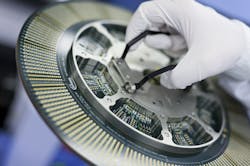Cutting the Cost of Gallium Nitride
Power amplifiers based on gallium nitride can handle higher voltages and hotter temperatures than silicon. But the better performance of gallium nitride – more commonly known as GaN – comes at a steeper cost than silicon, which has billions of dollars of investment and decades of innovation under its belt.
In an attempt to slash the price tag, companies are striking deals to manufacture gallium nitride on a larger scale. On Wednesday, Macom announced that it would use STMicroelectronics as a second source for its GaN chips, which are layered on thin slabs of silicon for use in telecom infrastructure. These chips could also be used to power 5G base stations and the massive antenna arrays inside them.
The production pact is focused on expanding the market share for gallium nitride. By increasing its supply, Macom said that it could lower the cost of its products to the point where they could displace LDMOS transistors, which are manufactured cheaply out of silicon and broadly used as power amplifiers inside 3G and 4G cellular base stations.
Macom also agreed to license its gallium nitride-on-silicon technology to STMicroelectronics, which expects to start sample production in 2018. The agreement gives the company the right to sell its own products as long as it avoids the markets for smartphones, base stations and telecom equipment that Macom is targeting.
STMicroelectronics, based in Geneva, Switzerland, is eyeing applications that dovetail more with its discrete electronics business. It plans to develop GaN chips that concentrate radio waves into beams that can cook food, cure industrial ceramics, and generate heat to power extremely efficient light bulbs and more efficient spark plugs in cars.
Analysts say that these opportunities, though still small, could introduce billions of dollars of new revenue into the market for radio frequency devices. Marco Monti, automotive and discrete product group president for STMicroelectronics, said that the deal “delivers the economic breakthroughs necessary to expand the market for GaN on silicon.”
The gallium nitride-on-silicon transistors produced as part of the deal can replicate the performance and reliability of gallium nitride devices bonded to a bed of silicon carbide, said John Croteau, chief executive of Macom. Silicon carbide (SiC) is more expensive but it gives gallium nitride the ability to handle higher voltages and temperatures encountered in missile defense radar and other powerful systems.
Silicon is a cheaper substrate material than silicon carbide. Macom uses six-inch wafers to make gallium nitride-on-silicon technology at its factory in Lowell, Massachusetts. But the company hopes to move to eight-inch wafers in the future to further drive down costs, mirroring what its rival Qorvo has done. In contrast, most companies manufacture GaN-on-SiC transistors on four-inch wafers.
Gallium nitride is also used in radar and satellite systems, giving national security officials pause about its proliferation. Last year, the Committee on Foreign Investment in the United States shot down Infineon’s proposed $850 million deal to acquire Wolfspeed, the power and radio frequency division of Cree, which is approved to manufacture custom chips for the Department of Defense.
Macom has worked for more than two years to transfer its manufacturing technology to traditional CMOS factories run by STMicroelectronics. It is unclear how many of STMicroelectronics' 11 factories worldwide are capable of churning out GaN and which ones will. Macom did not disclose more specific terms of the deal.
About the Author

James Morra
Senior Editor
James Morra is the senior editor for Electronic Design, covering the semiconductor industry and new technology trends, with a focus on power electronics and power management. He also reports on the business behind electrical engineering, including the electronics supply chain. He joined Electronic Design in 2015 and is based in Chicago, Illinois.
